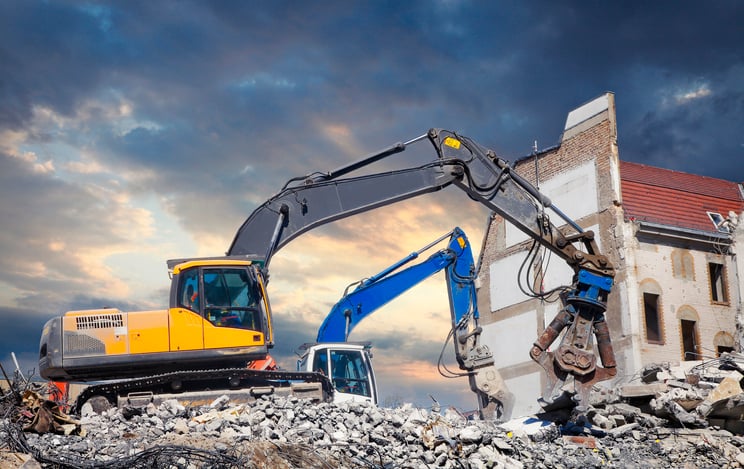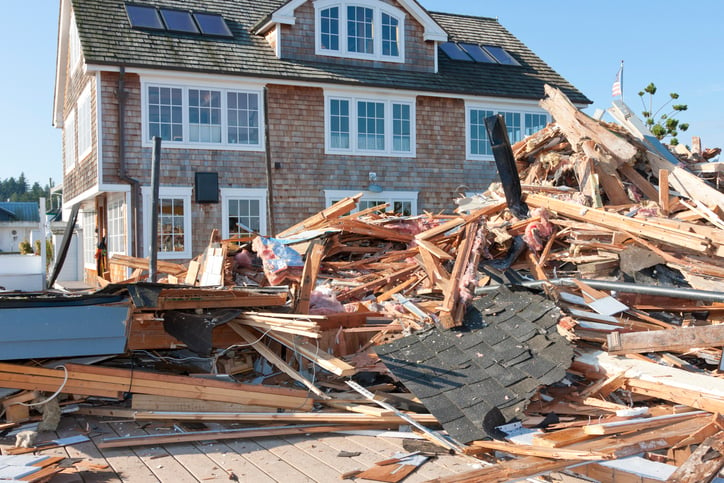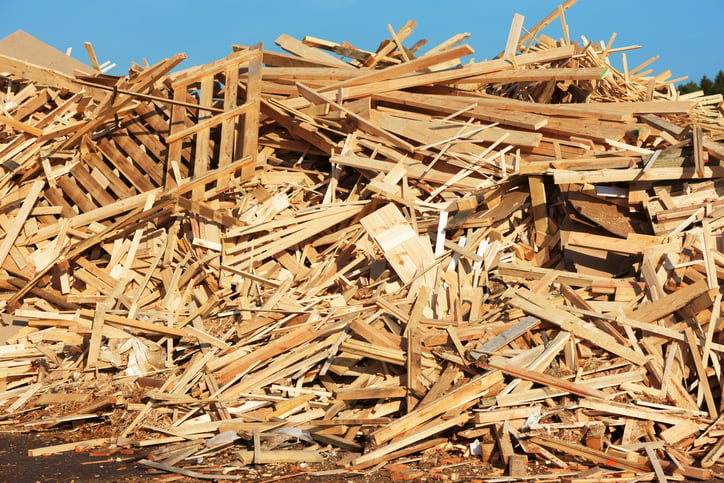
The word “waste” rings especially discordant in construction as an industry whose bottom line relies on the efficient marshalling of resources. And yet, for all of our advances in technology and logistical know-how, construction in the early 21st Century remains an enormous producer of waste, discarding mountains of usable material every day.
In this article, we’ll take a look at the construction industry’s waste problem and consider some potential solutions.
What Is Construction Waste
We’ve talked about running out of materials (stockouts) and setting aside material for a rainy day (safety stock). Construction waste, on the other hand, is what happens when you have excess material that you simply can’t use.
Construction and demolition waste refers to any building materials that get discarded during the construction, renovation, and demolition of buildings, roads, bridges, and other infrastructure.
Per the Environmental Protection Agency, construction waste includes, steel, glass, wood, drywall, plaster, brick, clay tiles, shingles, concrete, and asphalt. This of course is not an exhaustive list. Construction is a dynamic field that encompasses a wide variety of project types, each of which can generate its own unique waste profile. As we'll see in a moment, construction waste is caused by a number of factors, including bad planning, poor communication, and wasteful construction practices.
Due to the the nature of construction, some amount of waste will always be generated by a building project. The question is: How can we reduce it?
The Construction Industry’s Waste Problem
600 million tons. That’s how much material was wasted by the American construction and demolition sector in 2018, according to a report by the EPA. This is equivalent to the weight of about 2,600 fully-stocked luxury cruise ships.
That’s an alarming amount of waste, but it’s not like we haven’t seen this coming. The EPA estimates that the construction industry generated about 136 million tons of waste in 1996. The industry's contribution to the trash heap has steadily grown since then, ballooning by about 126% by 2018. And we’re not slowing down. Today, building an average-sized home creates about 10,000 pounds of debris, according to Waste Advantage Magazine. At the current rate, the volume of waste materials produced annually in the United States is expected to exceed 2.2 billon tons by 2025, according to a report by Transparency Market Research.

Why Is Construction Waste A Problem
We live in a throwaway culture that treats everything from products and resources to human beings as disposable. Under this paradigm, it’s acceptable, and even structurally incentivized, to toss items into the rubbish bin after a single use, or simply because they’re not to our liking.
Fast fashion, planned-obsolescence, and single-use plastics like coffee pods, plastic bags, and Styrofoam packing materials—these are just a few iterations of modern society’s addiction to disposability. To be fair, the construction industry is just one player in this throwaway game, but it’s also one of the largest. Altogether, researchers estimate that the global construction industry generates about 35% of the world’s total waste.
All this debris comes at a cost.
Construction Waste Costs Money
We literally throw money away when we waste building materials.
Construction waste accounts for about 30% of total project cost overruns, and as much as 15% of all purchased construction materials ends up wasted.
These figures are especially irksome in light of the fact that most building materials that get thrown away are still usable. Researchers estimate that more than 75% of all construction waste material has residual value and could be either reused or recycled. Instead, it ends up in the landfill.
Construction Waste Is Bad For Worker Safety
Disposing of construction waste can add hazard to what is already one of the most dangerous lines of work. If not properly stored or secured, on-site waste materials can fall, be scattered by wind, or be tripped upon, causing injury or even death to workers. Depending on the material, workers may also be needlessly exposed to toxic chemicals that have adverse long-term effects on their health.
Construction Waste Is Bad For The Environment
Construction waste doesn't just vanish from the Earth once it's disposed of. It lingers in the environment, emitting greenhouse gases like carbon dioxide and methane, thus adding to the industry's sizable contribution to climate change (the construction sector is responsible for nearly 40% of total CO2 emissions worldwide). Adding to the growth of landfills, construction waste also pollutes the soil and contaminates groundwater, breaking down over time into hazardous compounds that are harmful to human health. Building materials are often precious resources, the extraction of which is often deeply harmful to the environment, making their waste especially egregious.
What Causes Construction Waste?
In a 2019 paper published by the journal Sustainability, researchers identified 28 factors that contribute to the proliferation of construction waste. Mercifully, the researchers broke these factors down into four broad categories: Design, material procurement, construction methods, and human resources.
Design
Errors, lack of clarity, and lack of commitment to sustainability in building designs can lead to excess material that ultimately ends up wasted. A recent study showed that as much as 33% of construction waste is caused by the failure of architects to include waste reduction measures in their project designs.
Material Procurement
Communication breakdowns, mis-estimations during the procurement process, and materials lost, mishandled, or damaged in storage and transit can also contribute to construction waste.

Construction Methods
Construction is a complex industry full of moving part and there are a lot of opportunities for waste to be generated from beginning to end. Errors during the construction phase due to divergent building methods, for example, can lead to costly change orders that consequently create large amounts of waste.
Human Resources
Personnel and managerial staff can also generate construction waste if members of a team are not properly trained and in sync with one another about a waste management plan. Poor communication between contractors working at cross-purposes, for example, can lead to materials being improperly procured.
How to Reduce Construction Waste
The problem is clear enough.
Fortunately, so are the solutions.
Create a Waste Management Plan
One of the absolute best things you can do reduce waste and its negative consequences is to develop a rigorous waste management plan. This is exactly what it sounds like: A thorough policy and procedural framework that provides step-by-step guidance for how to properly manage and dispose of the various different types of waste that are generated during a construction project's life cycle. A good waste management plan will: provide projections for the amount of waste created, establish clear goals for recycling and reuse, identify specific procedures for specific types of waste materials, and layout detailed instructions for how workers can safely handle different types of waste (ideally in coordination with a designated safety manager).
Adopt Smarter Construction Techniques
Researchers have found that off-site construction methods can reduce construction waste by as much as 90%. Meanwhile, green warehousing and green building standards like LEED and BREEAM can provide guidance on how to reduce waste through the use of renewable building materials and other sustainable construction practices. When applied to material procurement and supply chain management, the tried-and-true methodology of lean construction, with its rigorous focus on efficiency and minimization of waste, also offers a clear path to eliminating construction waste before it can accumulate.
Reduce, Reuse, Recycle
Waste can be reduced simply by using no more than is needed. This can take careful planning to execute properly, but committing to a mindset that is intentional about how material is used and in what amounts is an essential starting point. It’s impossible to not create any waste, so do your best to reuse it. Instead of tearing down a building, give it a second life through adaptive reuse. If there’s no way to avoid tearing the building down, deconstruct it instead of demolishing it, salvaging materials like copper, wood, and steel from within to be reused in other projects. And if the materials can’t be reused, recycle them, as green concrete for example. Not only is this good for the environment, it can also save you money come tax season.
Embrace Technology
Construction has been historically slow at embracing advances in technologies, but some of those advances can help the industry become more efficient and less wasteful.
3D printing allows builders to construct buildings layer by layer, an additive construction technique that reduces waste by using no more material than is necessary. In a recent report for the Institute of Physics, researcher Nhlalala Michelle Liphadzi also identified Building Information Modeling (BIM) as an effective tool for strategizing about ideal building materials and visualizing ways to minimize waste in the final design. Inventory management platforms like the free-to-use ONE-KEY™ app, with its easy customization, tracking, and management features, can also cut back on waste by enabling users to keep better track of the physical conditions and locations of tools, equipment, and other mission-critical resources.
Bottom Line
Despite a growing body of knowledge about its negative impacts, the amount of construction waste has exploded over the last two decades. There will always be some waste generated by construction, but the costs to worker safety, the environment, and the industry’s bottom line should give us pause. It is ultimately in all of our interests to reduce waste in the construction industry. Some good places to start include creating a waste management plan; adopting a reduce, reuse, recycle mindset; embracing new technologies; and adopting smarter construction techniques. By tackling construction's waste problem head on, industry leaders can put a dent in the landfill that will help protect people and the natural environment while also enriching the built one.